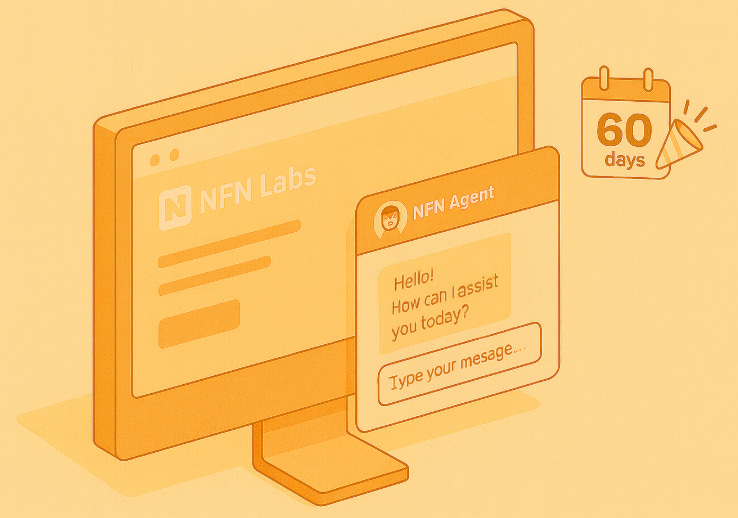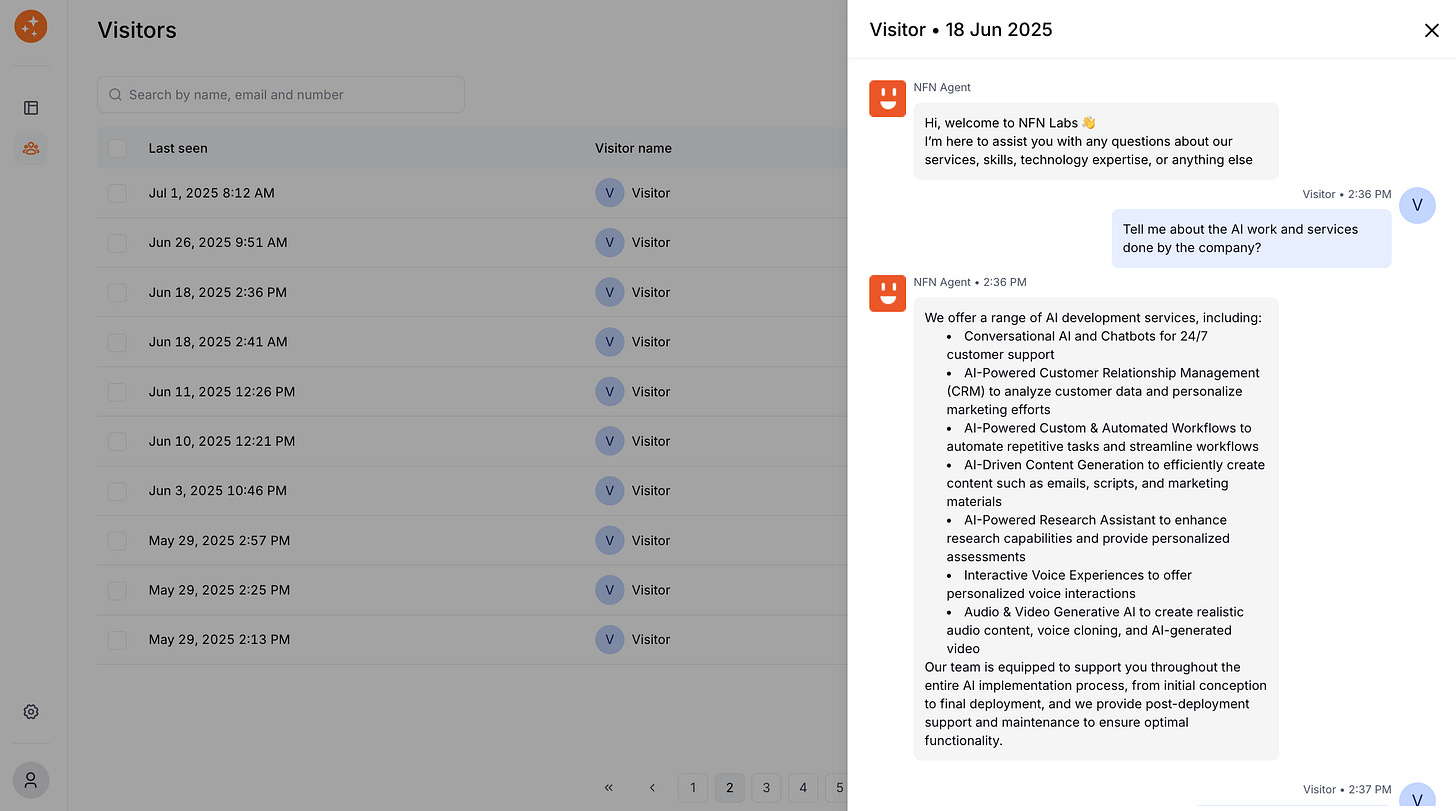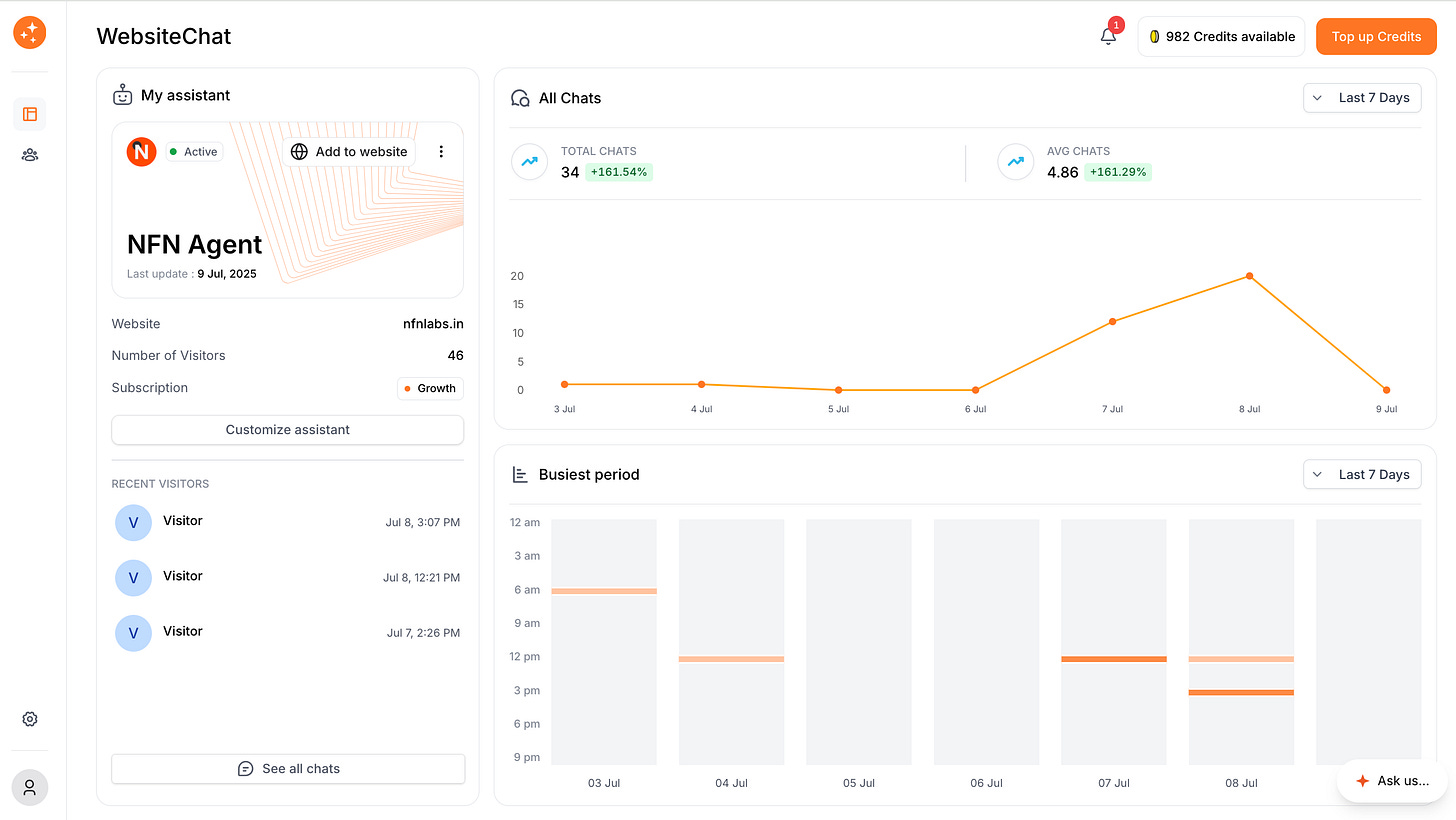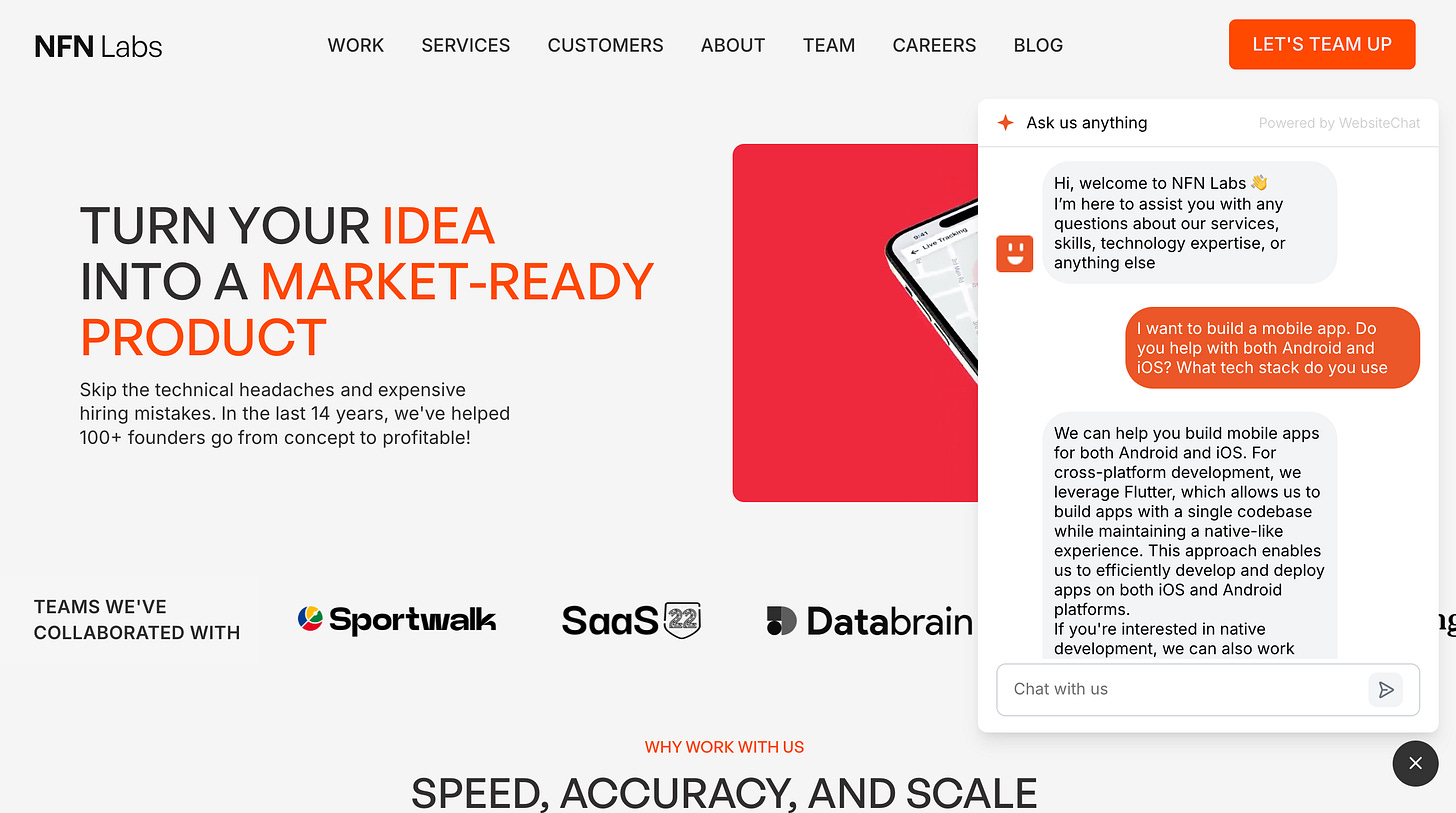Two Months In: What We’ve Learned from Embedding an AI Assistant on Our Website
Launched just 2 months back, our no-code AI assistant - WebsiteChat is already giving us new user insights and round-the-clock support coverage. In this post, we share a transparent check-in on what changed (and what didn’t) in the first 60 days after deploying our AI assistant on our own websites.
Introduction
At NFN Labs, we recently integrated our AI chat assistant into our company website and our product site. One of the core reasons we built this no-code AI assistant was to ensure no visitor goes unanswered, even when our team is offline. We’re already started noticing some small, practical, measurable changes. From providing 24/7 support to capturing lead information, our AI assistant has quickly become an integral part of how we engage visitors. We’ve also gained valuable insights by analyzing what users ask and identified areas where our content needed improvement.
Below is a breakdown of the key changes we observed along with how these early results line up with our expectations.
1. 24/7 User Support – No Visitor Goes Unanswered
In just a few weeks, our AI assistant has answered lots of queries that would have otherwise been missed during weekends or late nights. Now, whenever someone visits our site at 11 PM or on a Sunday afternoon, they can still get answers instantly. Previously, those inquiries might have gone unanswered until the next business day (or not at all), risking lost opportunities or frustrated visitors. By having a bot available at all hours, we ensure that inquiries are addressed without delay – a huge benefit for users in different time zones or those browsing after hours.
No matter when a question comes in, the assistant greets the visitor and provides help. Not only does this improve the user experience, it also gives us peace of mind that no potential lead slips through the cracks. It aligns with industry findings that AI chatbots enable “round-the-clock customer support, ensuring inquiries are addressed without delays”. In short, our site is never “closed” to someone who needs information.
2. Learning What Users Are Actually Asking
Another immediate benefit has been new insight into our visitors’ true questions and concerns. By reviewing the chat transcripts, what people ask about most. The top frequent queries so far have been about job applications, service enquiries, and our tech stack. This gave us a helpful reality check — we realized we hadn’t updated some of our job listings or content around our services recently. Thanks to these insights, we quickly made updates to the website and FAQs to ensure visitors can now find this information more easily
Seeing real questions phrased in users’ own words is like having a constant stream of user feedback. Instead of guessing what information visitors need, we have direct data. In fact, AI chat interactions can uncover patterns that help businesses improve their products, services, and support. We’re leveraging these patterns to make our site content more intuitive and helpful
3. Effortless Knowledge Updates (No Code Needed)
Keeping the assistant’s knowledge base up-to-date has proven to be easier than ever, especially compared to traditional support docs or coded chatbots. In a few cases, the assistant gave an incorrect or outdated response – not due to a flaw in AI, but simply because our content had changed and we hadn’t updated the source. Usually, correcting such issues might have involved editing a script or retraining a model. However, with our no-code WebsiteChat assistant, the fix was trivial: we just re-scraped the updated URL with one click.
The moment we refreshed the assistant’s knowledge base, it could start giving the corrected answer. This agility has been a huge relief for our team. It means our AI assistant’s responses can keep up with our fast-changing product information or policy changes. In practice, if we tweak pricing details or add a new feature to our docs, we simply instruct the assistant to ingest that updated page. Within seconds, the assistant is current and accurate again. This streamlined, no-code update process ensures users always get the latest info, and it saves our developers and content team a lot of time. We can maintain accuracy and trust in the answers without any technical friction.
4. Early Engagement Insights
We’ve started to glean early engagement insights from the assistant’s activity. One standout observation is when users tend to chat the most.
Knowing our peak engagement times is extremely useful. For one, it could help in planning our support and communication strategies. For example, if we know a lot of users are active in the afternoon, we could schedule important announcements or deploy more live staff support (if needed) during those hours. It also suggests that running marketing campaigns or live demos in that timeframe might get more attention. Essentially, these AI assistant analytics give us a data-driven way to optimize how and when we engage our audience.
5. Capturing Leads Through Conversations — Seamlessly
One useful insight from using our AI assistant internally has been how easily it supports lead capture during conversations. In WebsiteChat, we’ve enabled a built-in feature that prompts the assistant to collect basic visitor details — such as name, location, email, and phone number — after a certain number of queries from the visitor.
This data, along with the conversation history, is logged and viewable from our app. If a visitor asks questions that show potential buying interest — like pricing, services, or custom options — we can later review their conversation, validate their intent, and choose to reach out using the contact information we have provided.
What makes this effective is the conversational format: visitors are much more likely to engage and share details in a natural chat flow than in a static form. It feels less intrusive and more human. We're essentially giving them a smoother way to express interest, while collecting data that’s helpful for follow-ups.
6. Seamless Brand Integration of the Assistant
We put effort into making sure the AI assistant feels like part of our brand, and it’s paying off. Everything from the chat widget’s greeting message, layout, avatar, and even font has been configured to match our website’s design and voice. As a result, users don’t perceive the assistant as some third-party bot awkwardly bolted onto the site. Instead, it comes across as a natural extension of our team and branding. The first greeting message we have set is a friendly tone we’d use ourselves. The avatar and logo also align with our website’s theme.
Because of these customizations, the assistant truly blends in with the site, almost as if we had built it from scratch to fit our UI (in fact, we essentially did, using our own no-code tool!). This cohesion matters for user trust – if the chat assistant looked out of place or generic, visitors might hesitate to interact, suspecting it’s not official or secure. But when it matches the brand, it reinforces credibility. Internally, we’re happy that our AI assistant doesn’t feel like a separate entity, but rather like a friendly, on-brand helper waiting in the wings. It’s accomplishing the goal of improving service without sacrificing our brand identity or aesthetic.
7. Automating Repetitive Queries, Saving Team Bandwidth
Since adding WebsiteChat, we’ve seen a noticeable drop in repetitive queries reaching our inbox, contact form, and support calls. The AI assistant now handles these routine questions — like those about pricing, features, or setup — instantly using well-configured, accurate responses. Our team no longer needs to manually answer the same queries again and again.
As our user base grows, this benefit only becomes more valuable. The assistant essentially acts as a first line of support, responding to FAQs with speed and consistency — freeing up our human team to focus on deeper, high-touch conversations that require context or judgment.
This shift not only improves operational efficiency but also boosts user experience. Responses are faster, always available, and never miss a beat. Industry studies back this up — AI chat assistants have been shown to automate repetitive tasks and handle high volumes of queries at a fraction of the cost of traditional support and that businesses have reported reducing customer service loads by up to 51–68% during peak periods by using AI assistants.
For us, this means fewer interruptions for the team, and more time spent on what actually moves the needle — from product improvements to engaging with high-intent prospects. WebsiteChat is doing exactly what we built it for: offloading repetitive work so humans can focus on what matters.
So, What’s Next?
It’s still early days for us with WebsiteChat – two months is a short time – so we’re cautious about making any sweeping claims. However, it has already started delivering and is essentially doing what it was designed to do, by:
Offering 24/7 user support: Ensuring every visitor gets an instant response, no matter when they come by.
Capturing leads details: Engaging visitors and collecting their contact info in a friendly, automated way.
Surfacing gaps in our messaging: Providing chat history where we can monitor what information users struggle to find, so we can fix content or UX issues.
Saving the team time: Handling FAQs and repetitive queries, which frees up our team to focus on higher-value tasks.
Going forward, we’ll continue to track the assistant’s performance over the next quarter. We expect to learn even more as we gather additional data – for instance, how conversation quality changes as we refine the knowledge base, or how many leads per week we can consistently capture. We plan to share more updates as we go, perhaps at the 4-month or 6-month mark, to keep everyone posted on the impact this AI assistant is having on our business.
Want to try adding an AI assistant to your own site? We’d obviously encourage it! If you’re interested in what WebsiteChat can do for you, feel free to visit our site (no credit card required for free trial!) or reach out to us at support@websitechat.in for a free demo. Our solution is no-code and takes less than 5 minutes to go live – meaning you could start offering 24/7 support and capturing leads on your website by the end of today. We’re here to help if you have any questions, and we’d love to see more businesses benefit from the kind of results we’ve started to see in just a short time.




